Udmurt national costume
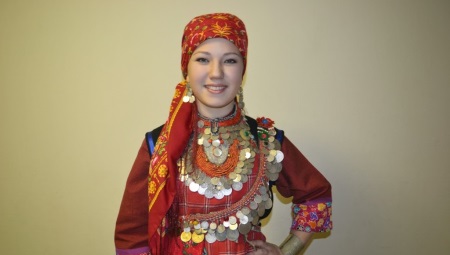
The national Udmurt costume is a symbol of hard work and accuracy. To fill their chest with a dowry, girls from 6-7 years old learned to spin, and the loom was the main assistant in this matter. And so, by the age of 16–17, they became craftswomen and handymen, they could make both an everyday dress and a wedding outfit. And anyone who wanted to get married had to have gifts for the future husband and his relatives. In general, in the chest of each self-respecting girl, there were more than 40 different outfits.



History and features
The Udmurts' costume is a talisman and protection from evil spirits. As Udmurts are divided into northern and southern, so their costumes differ in colors, elements and materials.

The first garment for the child was a shirt for a mother for a daughter, and a shirt for a father for a son. Until the age of three, children were wearing the clothes of their elders. This was not so much a saving as ensuring the comfort of the child, because the worn and washed clothes became soft and the new coarse fiber did not rub the delicate skin.

It used to be a simple shirt. Northern Udmurts used flax for its manufacture, and southern Udmurts used hemp. Sheepskin, canvas and broadcloth were also used and made at home. In cold weather, woolen threads were used. They were woven with a shortdare, which was worn over a shirt.
Over time, both silk and satin began to be used. This fabric was used for festive outfits.



In the post-war period, with the advent of factory weaving, the national costume began to fade into the background. Handicraft ceased to be appreciated and money entered the circulation.
An interesting feature of the costumes is that when the craftswoman was finishing her work, she made her mark from a bunch of threads (chuk).It was a kind of trade mark, brand. This costume was not allowed to be copied.


Today homespun canvases are again in demand and valuable, history is being restored. Now every Udmurt fashionista has her own modernized version of the Udmurt national costume with an inherent color scheme and decor.


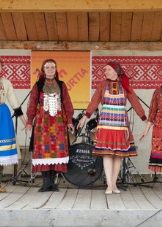

Colors and decor
The costume of the northern Udmurts contains three colors: white, black and red.
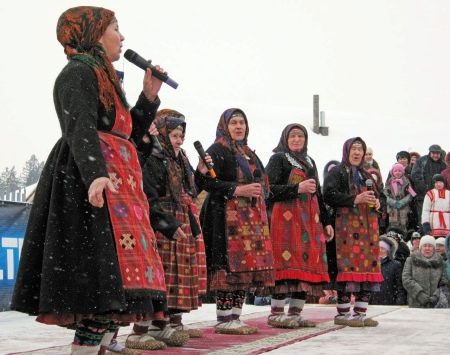
The southern Udmurts were distinguished by their bright, multicolored costumes. This included whites, reds, greens and browns.

Clothes and hats were decorated with beads, beads, coins, ribbons, embroidery with fragments of a talisman and a national pattern.



The embroidery on the shirts of men showed their occupation and also played the role of a talisman.

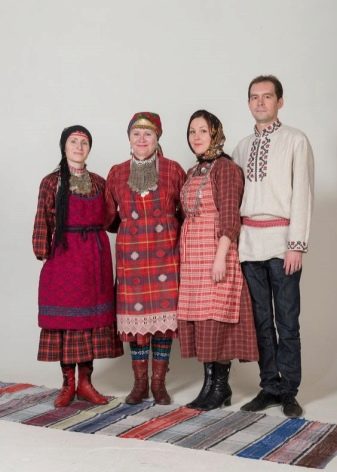
Men's suit
The men dressed simply. The traditional costume consisted of a shirt-shirt, striped trousers and a belt. The shirt was white, with trim, then a small checkered homespun fabric appeared. The pants (erez) of the Udmurts were close in their cut to the factory ones. The winter version of the trousers was made from homespun woolen cloth.


The festive version of the suit is a white shirt with red trim in the form of stripes on the sleeves and along the bottom of the shirt. Pants in solid black or blue. The wide belt is simply red or iridescent woven.


In winter, a fitted shortdarem was worn over the shirt. In cold weather they wore a sukman - a caftan, or dukes. On top of all this, sheepskin coats were worn, belted with woven belts and belts. For long-distance roads, there was also a long sheepskin coat with a large collar.
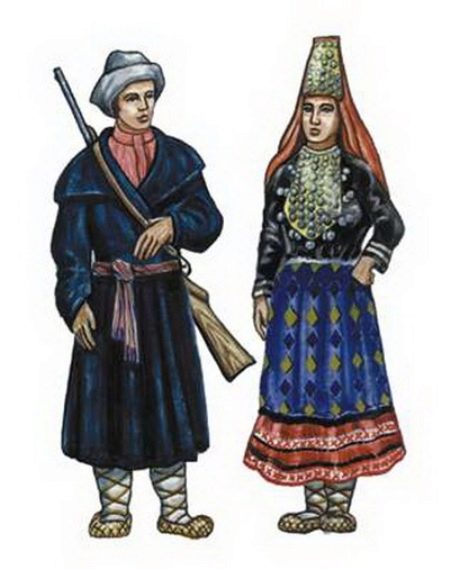
The headdress was a cloth cap or a felted sheepskin or wool (izy) hat. Shoes were worn made of bast - bast shoes, later they were replaced by boots, and in winter they were rescued by felt boots.

Woman suit
Women's clothing differed in several ways:
- place of residence (northern, southern);
- the age of the owner;
- family status.

Northern Udmurts adopted the clothes of the Perm peoples. The basis of the Northern Udmurt woman's costume was a derem - a long tunic-like shirt. On top of it, they wore zucchini - a rectangular bib with national embroidery, a shortdarem - a robe, and an azkyshet - an apron without a top, attached to a belt, and a braided belt or belt with embroidery.
Kabachi was an element of the clothes of married women; they were replaced by applique musarez - bibs made of pieces of fabric with embroidery, decorated with buttons and coins.



In winter, he warmed the quilimo with a shortdarem - a caftan over a shirt and a sheepskin coat of red or black color.

The headdress combined several elements: a hat, a veil, a headband. The basis was takya - a hat decorated with coins. For girls, there was a low takya kotress, but for older girls it was already taller - kuziales takya. They also wore headbands decorated with ribbons and embroidery, and married women wore yyr kotyr or vesyak kyshet - embroidered scarves.

The southern representatives of the Republic of Udmurtia stood out for their variegated fabrics. Their clothes are close to the Tatars and Bashkirs.
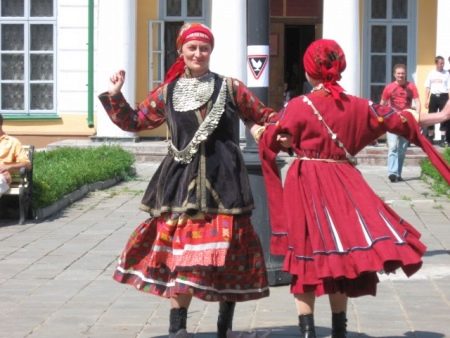
The basis of the suit is a shortdarem - an A-line dress with tapered sleeves. The edge was decorated with ribbons and frills. On the chest was a kykrak - a crescent-shaped bib with coins. Ayshet, an apron with a closed chest, was worn over it. Saestem - a sleeveless caftan and zybyn - warmed the caftan in the cool, and in winter they wore a herd - a sheepskin coat.


If everyday clothes were bright and variegated, then the wedding dress had mostly white colors.
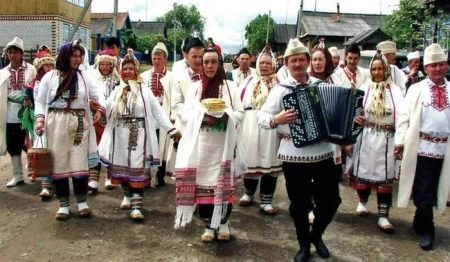
The headdress included hats, headbands, towels, aishons - hats with a high forehead, scarves. Southerners wore elaborate headdresses. A scarf was worn over the headband, decorated with beads and ribbons. At the wedding, the bride was wearing an aishon, and on top - a syulik - a wide embroidered canvas decorated with fringes. The girl wore this set until she became a mother, and married women also wore an embroidered towel, fixed on top with a scarf.



It was believed that the number of cells in the Udmurt woman's costume depended on how many children there would be in the family, the more, the better.

They wore chugles on their feet - stockings made of white or blue linen. Binyalton was wrapped over it - white portents up to the knee. For men, they were wider; later, knitted long socks with bright ornaments appeared. Bast shoes were also considered traditional shoes for women; for the holidays they were decorated with feathers and beads, and later they were replaced by holiday shoes. In winter, they put on felt boots.

Decorations
Women's jewelry clearly distinguished their mistresses. Bright bibs with coins served as a talisman for the hostess.

The headbands were decorated with bright ribbons, coins and beads.
The main material for jewelry was silver - bracelets, earrings, chains, rings. But the beads have not received such attention. But among the Udmurts such adornments as yyrpin - white shells were popular, played the role of amulets. Such adornments were passed down from the elders to the younger, being a family heirloom.


Married girls hid their hair under scarves and embroidered towels, but the girls decorated their knaps with braids, ribbons, narrow stripes with coins.

Southern Udmurts adorned themselves with a butmar - a sling over one shoulder with sewn coins. But the northern ones also added red beads to it.

Men from jewelry wore only rings, but not simple ones, but with a generic seal.

The Udmurt national costume with complex elements and ornaments is being restored and altered today. The modernized options are transformed into simple dresses, skirts and shirts, but the ornament and chest decorations remain unchanged. At the moment, the Udmurt costume is experiencing a new rise, and is gaining more and more popularity.









